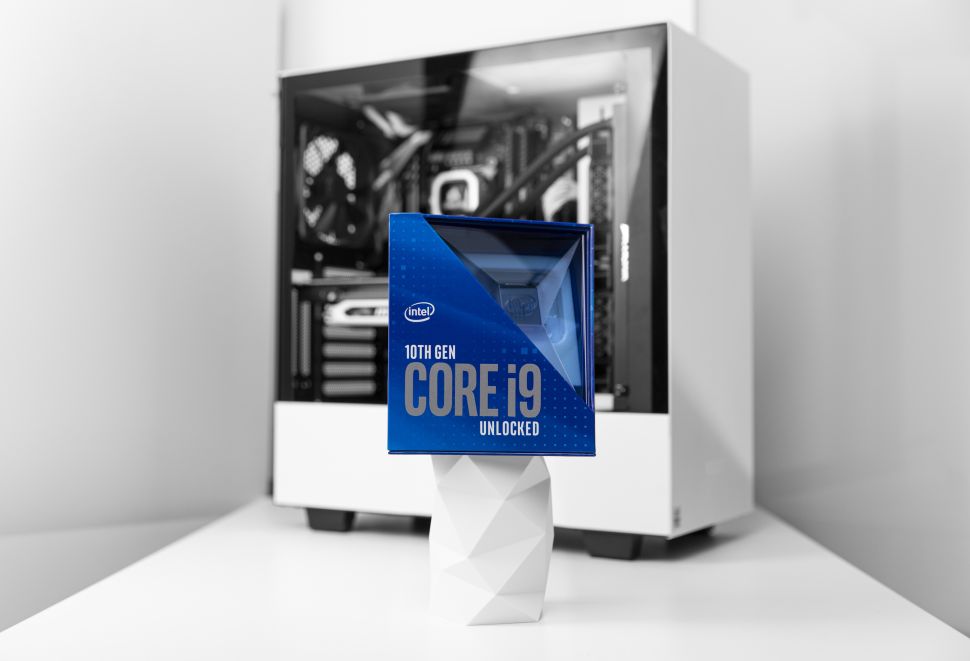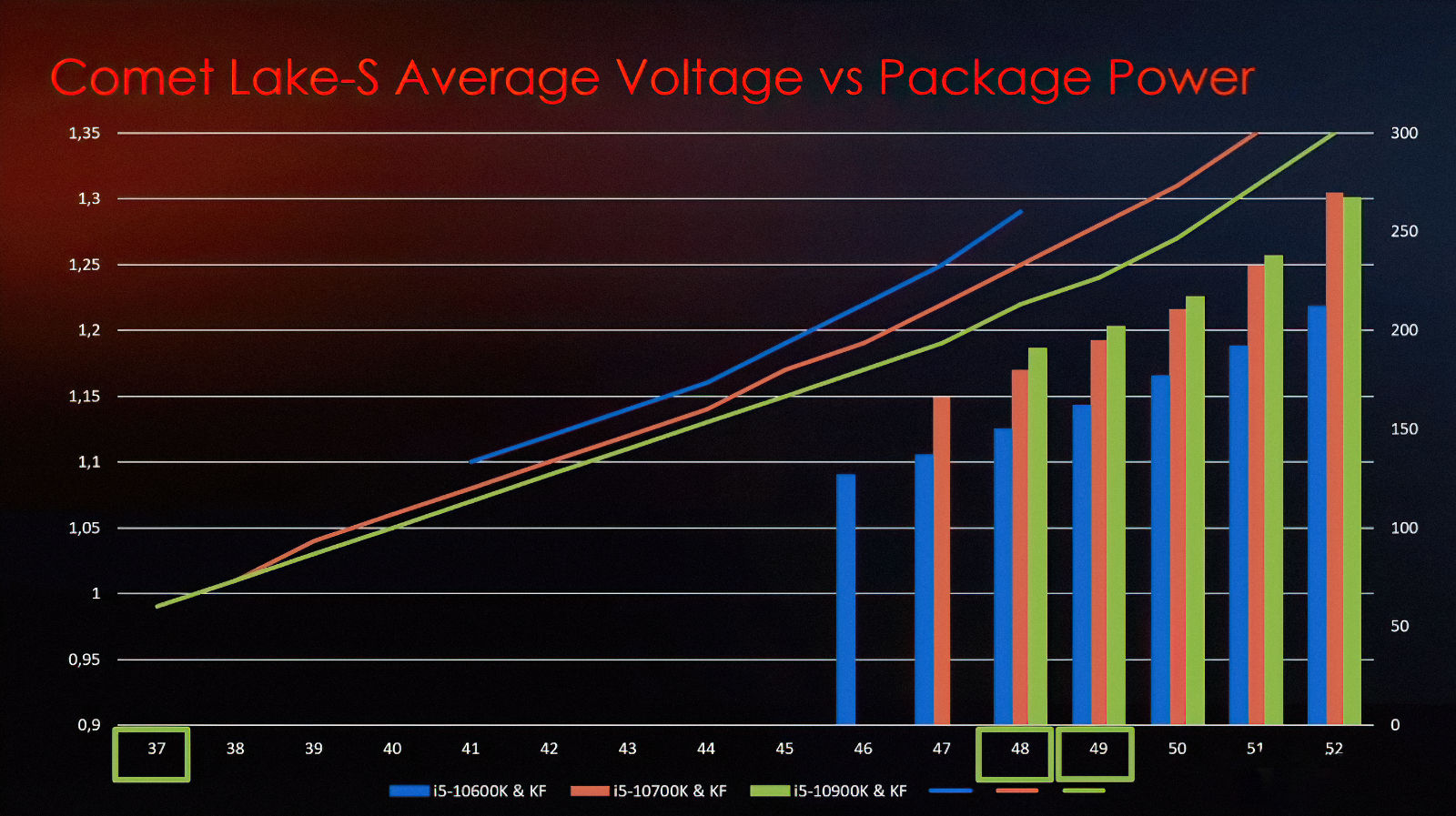Intel Comet Lake-S Overclocking: i9 CPUs Are Your Best Bet, MSI Data Shows

In a livestream, Eric van Beurden and Michiel Berkhout from MSI Netherlands discussed the wide array of Z490 motherboards that MSI built to host the upcoming Comet Lake-S CPUs. In addition to discussing the motherboards, however, they also touched on CPU overclocking, most notably their quality levels, as spotted by VideoCardz.
Of course, what this really is is a judgment of Intel's binning methods. MSI tested a handful of Intel Core i5-10600K, i5-10600KF, i7-10700K, i7-10700KF, i9-10900K and i9-10900KF processors and determined how well they run at different clock speeds and voltages.
MSI evaluates the chips and places them in one of three categories, based on quality level. Mid-tier Level B chips meet expectations, and Level A chips exceed performance expectations.
The execs said that Level C chips are "below the standard," and around 30% of Comet Lake-S silicon fit this category, according to MSI's testing. (Intriguingly, the percentages don't add up to 100%.) But don't panic; this only affects you if you want to overclock your CPU. A Level C chip that made it through Intel's Q&A is almost certainly still good enough to perform as advertised -- you just won't be able to hit high overclocks with it.
According to MSI's data, i5 and i7 chips rarely come with top-quality silicon. If you purchase an i9-10900K(F), however, there's a greater chance you'll get a chip that overclocks tremendously. Out of the batch that MSI sampled, 27% of these CPUs used the highest quality silicon. Of course, that doesn't guarantee your chip will achieve huge overclocks, but, alas, such is the nature of the silicon lottery.
MSI also shared a slide (above) detailing the average voltage required for running stable at different clock speeds. It seems that the i5 parts require higher average voltages to run the same clock speeds, whereas the i9 chips require a lower average voltage at all clock speeds.
If you're in the market for a Comet Lake-S i5 or i7 chip, you shouldn't expect a lot of overclocking room, based on MSI's data. But it's not surprising to see Intel apparently reserving its best silicon for the i9 chips.
Get Tom's Hardware's best news and in-depth reviews, straight to your inbox.
If Intel were to use the silicon from an i5 quality chip in the i9s, that CPU would need a higher core voltage to run stable, which in turns leads to higher power consumption and higher thermals. Those two things are exactly what Intel needs to avoid, given that it is squeezing every last bit of performance out of the 14nm process with Comet Lake-S.
Niels Broekhuijsen is a Contributing Writer for Tom's Hardware US. He reviews cases, water cooling and pc builds.
-
jimmysmitty The silicon lottery can be fun. My Q6600 G0 was one that I could OC to 3GHz AND lower the stock voltage (based on its VID) with a still extremly stable CPU. Ran cool as ice as well. But my 4570K is not as happy of an overclocking chip.Reply -
watzupken Why am I not surprised that i9 should have the better chips? MSI did their homework to quantify the odds of getting a grade A, B and C chip, but I am not sure how useful this information will be for a person looking to buy a new processor.Reply -
hotaru251 Reply
if your in the tech circle you know its all silicon lottery unless you literally buy a pre-binned cpu from places like silicon lottery site.watzupken said:but I am not sure how useful this information will be for a person looking to buy a new processor.
news just gives u the odds but your still at mercy of luck. -
watzupken Reply
This is exactly what I mean. I mean it should not come as a surprise that you need to get the highest end chips to increase your odds. Knowing the % of A grade chips is all good to know information, but does not make it a sure shot way of getting it. Even if it says 27% chance of getting an A grade chip does not automatically mean if I buy 4, 1 should be grade A. So in short, it is still highly random.hotaru251 said:
news just gives u the odds but your still at mercy of luck. -
hotaru251 Reply
hence "silicon lottery"watzupken said:So in short, it is still highly random.
its gambling like real lottery.
(and places that sell binned cpu mark em up becasue they know ppl WILL buy them even at premium)
its a static %.
like flipping a coin.
50% chance of tails, but even if you flip it a billion times you could never land on tails becasue its a static % that doesnt change. -
TerryLaze Reply
All tiers have a ~30% chance of only giving you default settings and maybe a little O/C.watzupken said:but I am not sure how useful this information will be for a person looking to buy a new processor.
All tiers have a ~50-60% to do at least a medium O/C.
Only the i9 have a decent ( ~30% ) chance of a high O/C
For a normal person looking to buy a new processor this info is interesting at most but not very useful other than seeing that they will get at least the advertised performance out of them,which already is an achievement in our day of age. -
jgraham11 Tom's is losing credibility again...Reply
This comment is not right and is completely contradictory to what MSI's research says:
"A Level C chip that made it through Intel's Q&A is almost certainly still good enough to perform as advertised -- you just won't be able to hit high overclocks with it. "
What are you basing that comment on? Why are you standing up for Intel without siting evidence for this? Blind faith...
This is going to be the same as the 9900k, overclocked right out of the box to operate at the highest frequency possible, power use be damned! -
TerryLaze Reply
You are confusing motherboards with CPUs here,what you describe is what happens if you use a motherboard that doesn't comply to intel's guidelines and just pumps as much power into the CPU as possible.jgraham11 said:This is going to be the same as the 9900k, overclocked right out of the box to operate at the highest frequency possible, power use be damned!
That's the same for ryzen for FX and for earlier intel chips,a lot of mobos use way too much power.
At normal loads even when overclocked to 5Ghz the power draw is pretty low.
-
PCWarrior So according to MSI:Reply
For the i9 10900K/KF the required voltage for a 5.0GHz all-core overclock is on average 1.26V; for 5.1GHz is on average 1.30V; and for 5.2GHz is on average 1.35V.
The distribution of these chips is 27% great overclockers, 35% average overclockers, 27% limited overclockers.
From the above it follows that:
27% of the chips will do all-core 5.0GHz with a voltage lower than 1.26V
35% of the chips will do all-core 5.0GHz with a voltage equal to 1.26V,
27% of the chips will do all-core 5.0GHz with a voltage higher than 1.26V.
27% of the chips will do all-core 5.1GHz with a voltage lower than 1.30V
35% of the chips will do all-core 5.1GHz with a voltage equal to 1.30V,
27% of the chips will do all-core 5.1GHz with a voltage higher than 1.30V.
Also, following the same logic for the 5.2GHz data, it follows that:
27% of the chips will do all-core 5.2GHz with a voltage lower than 1.35V
35% of the chips will do all-core 5.2GHz with a voltage equal to 1.35V,
27% of the chips will do all-core 5.2GHz with a voltage higher than 1.35V
So it is safe to say that nearly all 10900K/KF chips will be able to hit an all-core overclock of 5.0GHz with a voltage that does not exceed 1.3V and an all-core overclock of 5.2GHz with a voltage that does not exceed 1.4V. Also 62% of them will be achieving 5.0GHz with a voltage that does not exceed 1.26V and 5.2GHz with a voltage that does not exceed 1.35V. And probably the top 27% will do 5.1GHz with around 1.2V and 5.4GHz with around 1.4V. -
cryoburner Reply
Not necessarily. As the article points out, "Intriguingly, the percentages don't add up to 100%."TerryLaze said:All tiers have a ~30% chance of only giving you default settings and maybe a little O/C.
All tiers have a ~50-60% to do at least a medium O/C.
Only the i9 have a decent ( ~30% ) chance of a high O/C
For a normal person looking to buy a new processor this info is interesting at most but not very useful other than seeing that they will get at least the advertised performance out of them,which already is an achievement in our day of age.
If you look at the numbers in the graph, 15% of 10600K results are not accounted for, 5% of 10700K results are not accounted for, and 11% of 10900K results are not accounted for. Since these clearly don't fit in above the "A class", it's likely that they belong to an even lower "D class" that's not included in the graphs.
So, why aren't they included in the graphs? And why is MSI releasing overclocking details for processors that should still be under NDA restrictions? The answer is obvious, that these graphs are sanctioned by Intel, and they didn't want "D class" processors mentioned in what is essentially an advertisement to promote their new lineup.
In any case, I don't think there's any mention of what the sample size is for this data, and there's no way of telling whether the CPUs sent to MSI by Intel are even representative of how the processors available at retail will overclock, so not a whole lot can be gathered from this data. Results from other sources like Silicon Lottery will probably be at least a bit more meaningful.
Also, while their data may have shown the i9s overclocking slightly easier than the i7s, that may not be true in most real-world scenarios, where the extra heat from those additional cores is likely to be more of a concern, in a typical case, with a typical AIO cooler, and a power-hungry graphics card installed alongside them.



